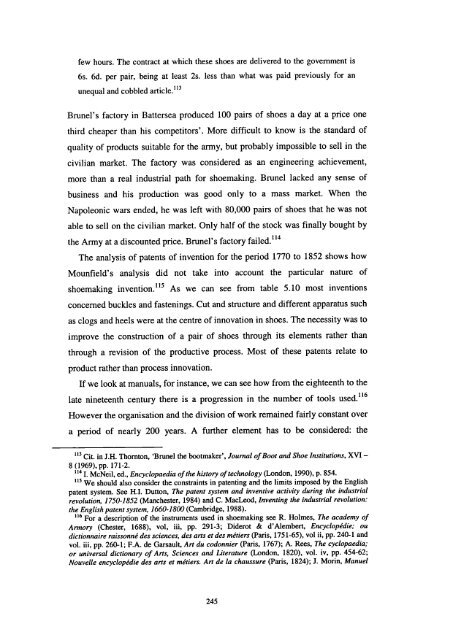The Boot and Shoe Trades in London and Paris in the Long Eighteenth Century
The Boot and Shoe Trades in London and Paris in the Long Eighteenth Century
The Boot and Shoe Trades in London and Paris in the Long Eighteenth Century
You also want an ePaper? Increase the reach of your titles
YUMPU automatically turns print PDFs into web optimized ePapers that Google loves.
few hours. <strong>The</strong> contract at which <strong>the</strong>se shoes are delivered to <strong>the</strong> government is<br />
6s. 6d. per pair, be<strong>in</strong>g at least 2s. less than what was paid previously for an<br />
unequal <strong>and</strong> cobbled article.113<br />
Brunel's factory <strong>in</strong> Battersea produced 100 pairs of shoes a day at a price one<br />
third cheaper than his competitors'. More difficult to know is <strong>the</strong> st<strong>and</strong>ard of<br />
quality of products suitable for <strong>the</strong> army, but probably impossible to sell <strong>in</strong> <strong>the</strong><br />
civilian market. <strong>The</strong> factory was considered as an eng<strong>in</strong>eer<strong>in</strong>g achievement,<br />
more than a real <strong>in</strong>dustrial path for shoemak<strong>in</strong>g. Brunel lacked any sense of<br />
bus<strong>in</strong>ess <strong>and</strong> his production was good only to a mass market. When <strong>the</strong><br />
Napoleonic wars ended, he was left with 80,000 pairs of shoes that he was not<br />
able to sell on <strong>the</strong> civilian market. Only half of <strong>the</strong> stock was f<strong>in</strong>ally bought by<br />
<strong>the</strong> Army at a discounted price. Brunel's factory failed."4<br />
<strong>The</strong> analysis of patents of <strong>in</strong>vention for <strong>the</strong> period 1770 to 1852 shows how<br />
Mounfield's analysis did not take <strong>in</strong>to account <strong>the</strong> particular nature of<br />
shoemak<strong>in</strong>g <strong>in</strong>vention. 115 As we can see from table 5.10 most <strong>in</strong>ventions<br />
concerned buckles <strong>and</strong> fasten<strong>in</strong>gs. Cut <strong>and</strong> structure <strong>and</strong> different apparatus such<br />
as clogs <strong>and</strong> heels were at <strong>the</strong> centre of <strong>in</strong>novation <strong>in</strong> shoes. <strong>The</strong> necessity was to<br />
improve <strong>the</strong> construction of a pair of shoes through its elements ra<strong>the</strong>r than<br />
through a revision of <strong>the</strong> productive process. Most of <strong>the</strong>se patents relate to<br />
product ra<strong>the</strong>r than process <strong>in</strong>novation.<br />
If we look at manuals, for <strong>in</strong>stance, we can see how from <strong>the</strong> eighteenth to <strong>the</strong><br />
late n<strong>in</strong>eteenth century <strong>the</strong>re is a progression <strong>in</strong> <strong>the</strong> number of tools used.'16<br />
However <strong>the</strong> organisation <strong>and</strong> <strong>the</strong> division of work rema<strong>in</strong>ed fairly constant over<br />
a period of nearly 200 years. A fur<strong>the</strong>r element has to be considered: <strong>the</strong><br />
113 Cit. <strong>in</strong> J.H. Thornton, 'Brunel <strong>the</strong> bootmaker', Journal of <strong>Boot</strong> <strong>and</strong> <strong>Shoe</strong> Institutions, XVI -<br />
8 (1969), pp. 171-2.<br />
114<br />
McNeil, ed., Encyclopaedia of <strong>the</strong> history of technology (<strong>London</strong>, 1990), p. 854.<br />
We should also consider <strong>the</strong> constra<strong>in</strong>ts <strong>in</strong> patent<strong>in</strong>g <strong>and</strong> <strong>the</strong> limits imposed by <strong>the</strong> English<br />
patent system. See HI. Dutton, <strong>The</strong> patent system <strong>and</strong> <strong>in</strong>ventive activity dur<strong>in</strong>g <strong>the</strong> <strong>in</strong>dustrial<br />
revolution, 1750-1852 (Manchester, 1984) <strong>and</strong> C. MacLeod, Invent<strong>in</strong>g <strong>the</strong> <strong>in</strong>dustrial revolution:<br />
<strong>the</strong> English patent system, 1660-1800 (Cambridge, 1988).<br />
116 For a description of <strong>the</strong> <strong>in</strong>struments used <strong>in</strong> shoemak<strong>in</strong>g see R. Holmes, <strong>The</strong> academy of<br />
Armory (Chester, 1688), vol. iii, pp. 291-3; Diderot & d'Alembert, Encyclopédie; ou<br />
dictionnaire raissonné des sciences, des arts et des métiers (<strong>Paris</strong>, 175 1-65), vol ii, pp. 240-1 <strong>and</strong><br />
vol. iii, pp. 260-1; F.A. de Garsault, Art du codonnier (<strong>Paris</strong>, 1767); A. Rees, <strong>The</strong> cyclopaedia;<br />
or universal dictionary of Arts, Sciences <strong>and</strong> Literature (<strong>London</strong>, 1820), vol. iv, pp. 454-62;<br />
Nouvelle encyclopédie des arts et métiers. Art de la chaussure (<strong>Paris</strong>, 1824); J. Morn, Manuel<br />
245


